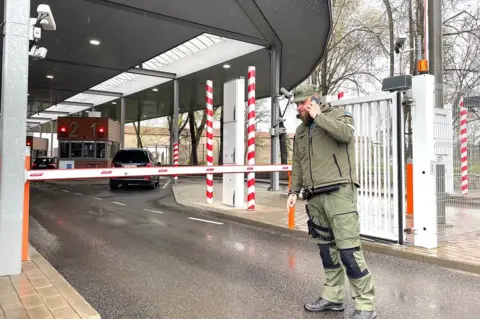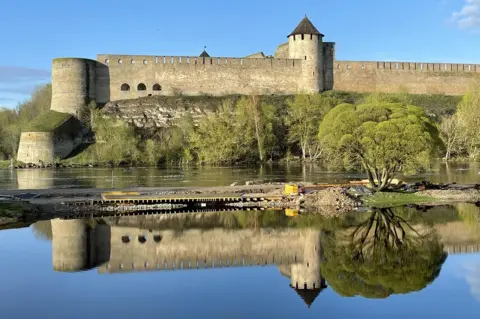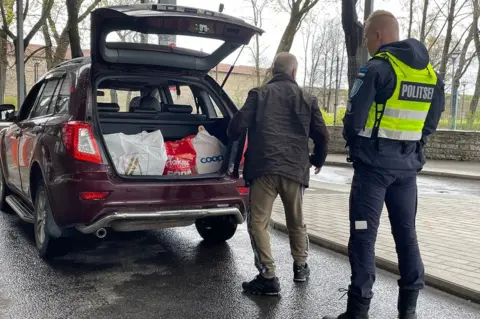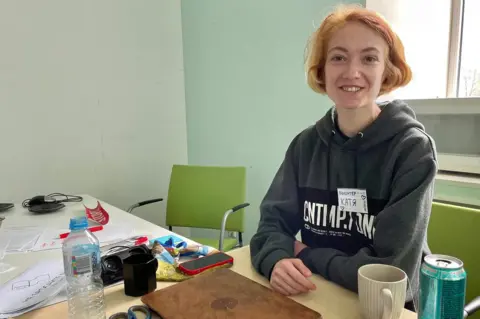Narva: The Estonian border city where Nato and the EU meet Russia
 BBC
BBCNarva is a strange place, almost an aberration. On the very edge of Nato's eastern flank, it is Estonia's third biggest city - but 97% of the nearly 60,000 people living there talk Russian, making it one of the largest Russian-speaking places in the EU by proportion of population.
It sits on the western bank of the River Narva that flows into the Baltic Sea. On the eastern bank is Russia. To a first-time visitor it feels like a classic Cold War frontier. Two giant fortresses face each other on opposing sides of the river, with the international border running down the middle.
To the west is Narva Castle, built by the invading Danes in the 13th Century. To the east is Ivangorod Fortress, built by a Muscovite Grand Prince in 1492.
Since much of Estonia's border with Russia crosses a lake, any future invasion by Moscow is thought likely to come either here or further to the south, next to Latvia.

Spanning the river at Narva is a road bridge, flanked by a high, chain-link fence topped with barbed wire and with customs posts at either end. Here I arrange to meet Erik Liiva. He's a superintendent in the border police or, to give him his Estonian title, he's a commissar. Tall, bearded and armed, he escorts me down the road to where a single red line is painted across the road.
"You have now reached the border," he tells me. "You are touching the edge of the Russian Federation."
So how are relations with your counterparts on the Russian side of the border since the Ukraine invasion, I ask.
"We don't have much contact with them," Liiva replies, "but we do have a hotline for operational reasons. We have enhanced our border patrols, we are doing much more thorough checks on vehicles coming through."

It is through this obscure border post, say the Estonian border police, that thousands of Ukrainians have been streaming - many having escaped the horrors of Mariupol and other war zones. Up to 300 a day have been crossing into Estonia, most of them moving on to other countries or returning to Ukraine.
In a bar in town I meet Katri Raik, the recently appointed mayor of Narva.
"Ukraine is our war," she says. "We feel it here."
When the invasion began, she says, there was a tense silence in the city, nobody spoke about it. Only 47% of people here are Estonians, 36% are Russians and the rest are classed as "aliens" - stateless persons, mostly Russian-speaking.
Before the invasion, people watched Russian programmes on TV and crossed over regularly to Ivangorod and beyond to St Petersburg, which is closer to Narva than Tallinn, the Estonian capital.
But now the respective consulates in Narva and St Petersburg have closed visas are hard to come by - and Estonia has banned Russian TV programmes as they are considered to be largely Kremlin propaganda.
Katri Raik, the mayor, has met many of the Ukrainians coming through her town.
"They have gone through hell," she says. "It is like the light in their eyes has gone out."

War in Ukraine: More coverage
- MILITARY STATUS: What might swing the Ukraine war?
- EVACUATIONS: Volunteer drivers risking lives for others
- CENSORSHIP: In fear or in jail: Telling the truth in Russia
- READ MORE: Full coverage of the crisis

In another part of town, I visit one of six volunteer aid centres set up to help the incoming Ukrainians. It is mostly staffed by young Russians and Ukrainians working for no pay - like Katya, from Russia.
"This border is the most convenient one in Europe for Ukrainians to cross over from Russia," she tells me. "Some of them have been evacuated from war zones by Russian troops, some voluntarily, some forcibly. By the time they get to the border they are exhausted and traumatised."

At the Russian border post at Ivangorod, the Ukrainians are subjected to lengthy questioning - especially the men. Security officers from Russia's feared FSB security service examine their phones for photographs, social media postings and contacts, then strip-search the men, looking for tattoos of nationalist coats of arms or regimental affiliations. They even look for shoulder bruises - caused by firing weapons. The interrogations can last for hours and anyone arousing suspicion is held for further investigation.
Yet some of those who have made it to the Estonian side are still critical of the West. At the volunteer centre, two elderly Ukrainian women from a village near Kharkiv eventually agree to speak to me in Russian as Katya interprets. They tell me they are grateful to the Russian soldiers who helped evacuate them to Belgorod on the Russian side of the border.
Who do you blame for this war, I ask them.
"It's like a divorce," answers Viktoria, cradling a small dog on her lap. "Because both sides are to blame. America is at fault as they should not have supplied weapons to Ukraine."
And what if Ukraine ends up being divided into zones ruled by Russia on one side and the legitimate government in Kyiv on the other? Where would you choose to live?
"Zelensky should not be president, he is a drug addict," answers Viktoria's friend, echoing the party line put out by the Kremlin.
"We would go to live in the Russian zone, of course."
Outside the centre another volunteer, Dennis, takes me aside to explain.
"It's an age thing," he says. "Even here in Narva a lot of the older people blame Nato and the West for this crisis. Younger people think differently. Even those who call themselves Russian are furious with Putin for causing this mess."
Estonia - along with its Baltic neighbours Latvia, Lithuania and Poland - is seriously worried about Russia's future intentions after the Ukraine invasion.
"Europe and Nato are facing a completely new reality" says Tuli Duneton, political director at Estonia's defence ministry. "An attack [from Russia] can no longer be excluded."
To deter any Russian ambitions to invade these four Baltic nations, Nato has rushed in reinforcements to shore up its eastern flank - part of what it calls its "Enhanced Forward Presence".
The UK, which leads Nato's multinational battlegroup in Estonia, has quickly doubled the size of its contingent in the country. There are now 28 Challenger 2 main battle tanks, 95 Warrior armoured vehicles and 12 AS90 artillery pieces.
Not enough to stop a concerted invasion by Moscow, but enough of a deterrent to act as a "tripwire" that would trigger the full force of Nato should Russia ever decide to cross the border.
Follow Frank on Twitter
